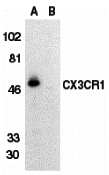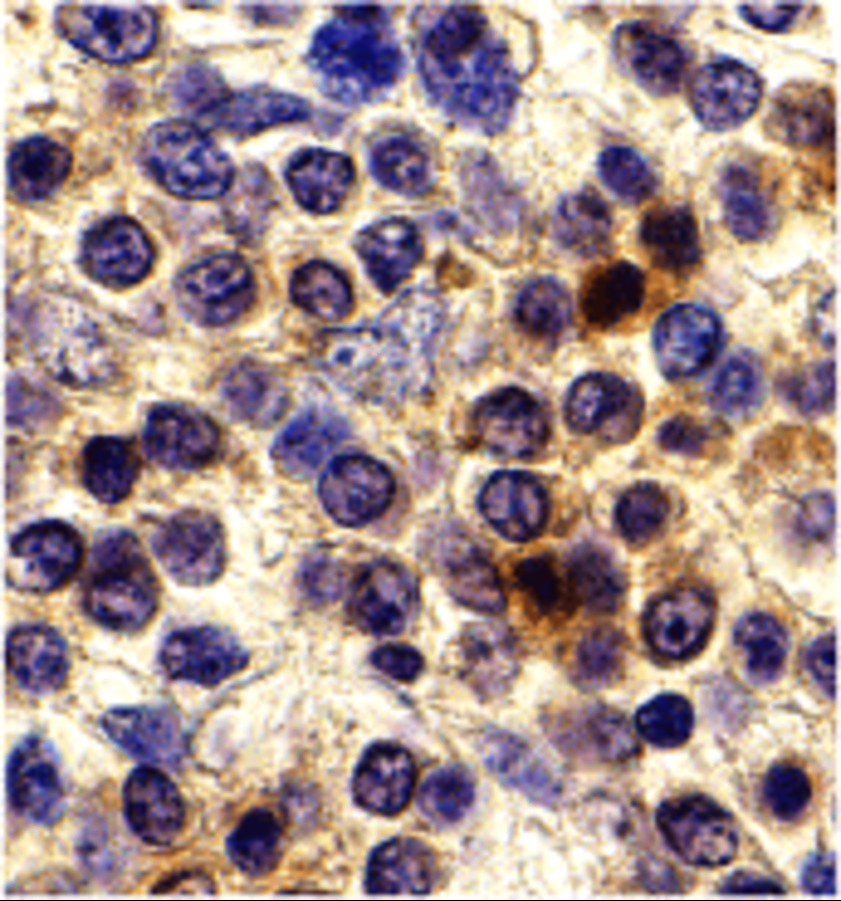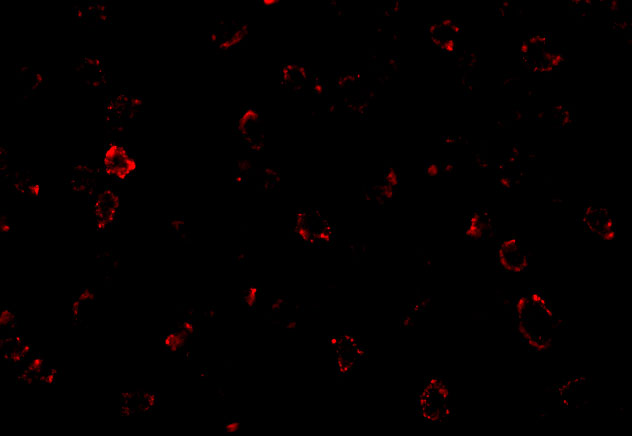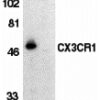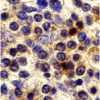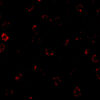Anti-CX3CR1 (EL) Antibody (2201)
$445.00
| Host | Quantity | Applications | Species Reactivity | Data Sheet | |
|---|---|---|---|---|---|
| Rabbit | 100ug | ELISA,WB,IHC-P,IF | Human, Mouse, Rat |  |
SKU: 2201
Categories: Antibody Products, Infectious Disease Antibodies, Products
Overview
Product Name Anti-CX3CR1 (EL) Antibody (2201)
Description Anti-CX3CR1 (EL) Rabbit Polyclonal Antibody
Target CX3CR1 (EL)
Species Reactivity Human, Mouse, Rat
Applications ELISA,WB,IHC-P,IF
Host Rabbit
Clonality Polyclonal
Isotype IgG
Immunogen Peptide corresponding to aa 175- 189 of human CX3CR1. The sequence is identical to that of rat CX3CR1 and differs from that of mouse CX3CR1 by one amino acid.
Properties
Form Liquid
Concentration Lot Specific
Formulation PBS, pH 7.4.
Buffer Formulation Phosphate Buffered Saline
Buffer pH pH 7.4
Format Purified
Purification Purified by peptide immuno-affinity chromatography
Specificity Information
Specificity This antibody recognizes human, mouse and rat CX3CR1 (50 kD).
Target Name CX3C chemokine receptor 1
Target ID CX3CR1 (EL)
Uniprot ID P49238
Alternative Names C-X3-C CKR-1, CX3CR1, β chemokine receptor-like 1, CMK-BRL-1, CMK-BRL1, Fractalkine receptor, G-protein coupled receptor 13, V28
Gene Name CX3CR1
Gene ID 1524
Accession Number NP_001328
Sequence Location Cell membrane, Multi-pass membrane protein
Biological Function Receptor for the C-X3-C chemokine fractalkine (CX3CL1) present on many early leukocyte cells; CX3CR1-CX3CL1 signaling exerts distinct functions in different tissue compartments, such as immune response, inflammation, cell adhesion and chemotaxis (PubMed:9390561, PubMed:9782118, PubMed:12055230, PubMed:23125415). CX3CR1-CX3CL1 signaling mediates cell migratory functions (By similarity). Responsible for the recruitment of natural killer (NK) cells to inflamed tissues (By similarity). Acts as a regulator of inflammation process leading to atherogenesis by mediating macrophage and monocyte recruitment to inflamed atherosclerotic plaques, promoting cell survival (By similarity). Involved in airway inflammation by promoting interleukin 2-producing T helper (Th2) cell survival in inflamed lung (By similarity). Involved in the migration of circulating monocytes to non-inflamed tissues, where they differentiate into macrophages and dendritic cells (By similarity). Acts as a negative regulator of angiogenesis, probably by promoting macrophage chemotaxis (PubMed:14581400, PubMed:18971423). Plays a key role in brain microglia by regulating inflammatory response in the central nervous system (CNS) and regulating synapse maturation (By similarity). Required to restrain the microglial inflammatory response in the CNS and the resulting parenchymal damage in response to pathological stimuli (By similarity). Involved in brain development by participating in synaptic pruning, a natural process during which brain microglia eliminates extra synapses during postnatal development (By similarity). Synaptic pruning by microglia is required to promote the maturation of circuit connectivity during brain development (By similarity). Acts as an important regulator of the gut microbiota by controlling immunity to intestinal bacteria and fungi (By similarity). Expressed in lamina propria dendritic cells in the small intestine, which form transepithelial dendrites capable of taking up bacteria in order to provide defense against pathogenic bacteria (By similarity). Required to initiate innate and adaptive immune responses against dissemination of commensal fungi (mycobiota) component of the gut: expressed in mononuclear phagocytes (MNPs) and acts by promoting induction of antifungal IgG antibodies response to confer protection against disseminated C.albicans or C.auris infection (PubMed:29326275). Also acts as a receptor for C-C motif chemokine CCL26, inducing cell chemotaxis (PubMed:20974991). {UniProtKB:Q9Z0D9, PubMed:12055230, PubMed:14581400, PubMed:18971423, PubMed:20974991, PubMed:23125415, PubMed:29326275, PubMed:9390561, PubMed:9782118}.; [Isoform 1]: (Microbial infection) Acts as coreceptor with CD4 for HIV-1 virus envelope protein. {PubMed:14607932, PubMed:9726990}.; [Isoform 2]: (Microbial infection) Acts as coreceptor with CD4 for HIV-1 virus envelope protein (PubMed:14607932). May have more potent HIV-1 coreceptothr activity than isoform 1 (PubMed:14607932). {PubMed:14607932}.; [Isoform 3]: (Microbial infection) Acts as coreceptor with CD4 for HIV-1 virus envelope protein (PubMed:14607932). May have more potent HIV-1 coreceptor activity than isoform 1 (PubMed:14607932). {PubMed:14607932}.
Research Areas Infectious Disease
Background CX3CR1 is one of the chemokine receptors that are required as co-receptors for HIV infection. The genes encoding human, murine, and rat CX3CR1 have been cloned and designated V28 and CMKBRL1, CX3CR1, and RBS11, respectively. This transmembrane protein was recently identified as the receptor for a novel transmembrane molecule, fractalkine, and was renamed CX3CR1. Recently, CX3CR1 was found to serve as a coreceptor for HIV- 1 and HIV-2 envelope fusion and virus infection, which can be inhibited by factalkine. CX3CR1 mediates leukocyte migration and adhesion and is expressed in a variety of human tissues and cell lines.
Application Images




Description Western blot analysis of CX3CR1 in THP-1 cell lysate with CX3CR1 antibody at 1 ug/mL in (A) the absence and (B) the presence of blocking peptide.

Description Immunohistochemistry of CX3CR1 in human spleen cells with CX3CR1 antibody at 10 ug/mL.

Description Immunofluorescence of CX3CR1 in THP-1 cells with CX3CR1 antibody at 20 ug/mL.
Handling
Storage This antibody is stable for at least one (1) year at -20°C. Avoid multiple freeze-thaw cycles.
Dilution Instructions Dilute in PBS or medium which is identical to that used in the assay system.
Application Instructions Immunoblotting: use at 1:500 dilution.
Positive control: Whole cell lysate of THP-1 cells.
Positive control: Whole cell lysate of THP-1 cells.
References & Data Sheet
Data Sheet  Download PDF Data Sheet
Download PDF Data Sheet
 Download PDF Data Sheet
Download PDF Data Sheet

